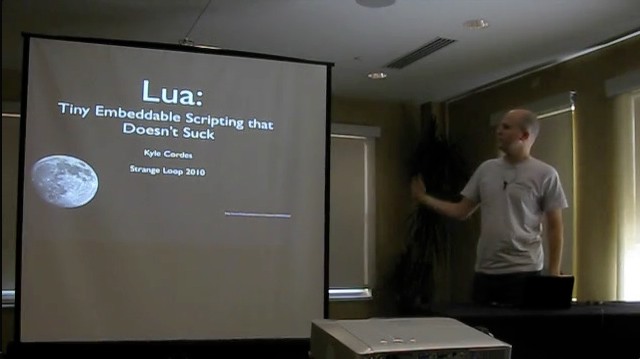At Strange Loop 2010, I gave a 20 minute talk on Lua. The talk briefly covered six reasons (why, not how) to choose Lua for embedded scripting. Lua is safe, fast, simple, easily learned, and more popular that you might expect.
The Strange Loop crew only recorded video in the two largest venues (out of six), so I made a “bootleg” video of my talk, for your viewing pleasure:

The video/audio sync starts out OK, but drifts off by a second or so by the end. The drift is minor, so it is reasonably viewable all the way through. If you don’t have Flash installed (and thus don’t see the video above), you can download the video (x264); it plays well on most platforms (including an iPad).
The slides are available for PDF download.
Video Hackery
This video recording was an experiment: instead of hiring a video crew (with professional equipment), or using my DV camcorder, I instead used the video recording capability of my family’s consumer-grade Canon digicam. This device has three advantages over my DV camcorder:
- No tape machinery; no motors; thus no motor noise in the audio.
- Smaller size, easier to carry in and out.
- Directly produces a video file, easily copied off its SD card.
As you can see from the results, the video quality is adequate but not great. Still, I learned that if I want to increase the quality of recording, the first step is not to use a better camera or lens! Rather, it is to bring (or persuade the venue to provide) better light. For good video results, the key is light the speaker well, without shining any extra light on the projector screen. With that in place, a better camera make sense.
The audio was a different story. Like nearly all consumer video cameras (and digicams with video), mine doesn’t have an external audio input, so the audio (from ~12 feet away) was awful. As a backup I had used a $75 audio recorder and a $30 lapel microphone, and that audio is very good, certainly worth using instead of the video recording audio track.
To combine the video in file A with the audio in file B, I used the ffmpeg invocation below. I reached the time adjustments below in just a few iterations of trial and error, by watching the drafts in VLC, using “f” and “g” to experiment with the audio/video time sync. I also trimmed off a bit of the bottom of the video, and used “mp4creator.exe -optimize”, which I had handy on a Windows machine, to prepare the file for progressive download viewing.
ffmpeg -y -ss 34.0 -i WS_10001.WMA -ss 34.0 -itsoffset -12.05 -i MVI_4285.AVI -shortest -t 8000 -vcodec libx264 -vpre normal -cropbottom 120 -b 400k -threads 2 -async 200 Cordes-2010-StrangeLoop-Lua.m4v
The remaining bits of technology are FlowPlayer, a WordPress FlowPlayer plugin, and a CDN.

One thought on “Lua Doesn’t Suck – Strange Loop 2010 video”
Comments are closed.